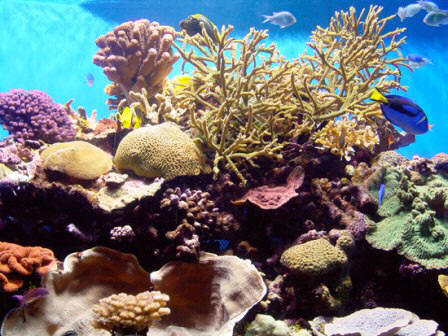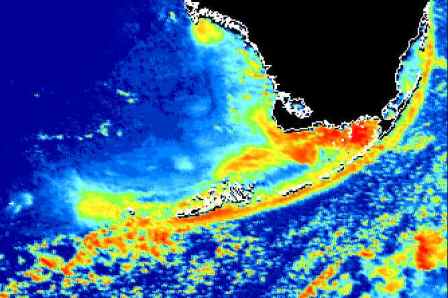Discover Florida Nature
It's time to explore the natural Florida


|
|
|
|
|
 Tropical
Coral Reefs are part of the Coastal Ecosystem. Florida's coastal
ecosystems are one of the greatest assets that Florida has. With more
coastline than any other state in the contiguous United States, they are
a source of both economic, environmental and recreational benefit.
People come from all over the world to visit the beautiful Florida
beaches. In addition to people
sea turtles also come from all over the world to lay their eggs on
Florida's Atlantic coast, one of only a handful of places in the world
that they come. The Florida reef tract is the most extensive living
coral barrier reef system in North American waters and the third largest
system in the world. Tropical
Coral Reefs are part of the Coastal Ecosystem. Florida's coastal
ecosystems are one of the greatest assets that Florida has. With more
coastline than any other state in the contiguous United States, they are
a source of both economic, environmental and recreational benefit.
People come from all over the world to visit the beautiful Florida
beaches. In addition to people
sea turtles also come from all over the world to lay their eggs on
Florida's Atlantic coast, one of only a handful of places in the world
that they come. The Florida reef tract is the most extensive living
coral barrier reef system in North American waters and the third largest
system in the world.SUBSTRATE: Limestone base created by skeletal deposits of dead corals and coralline algae. TOPOGRAPHY: Bank-reefs—three-dimensional, forest-like structures on continental margin seaward of larger islands of the Florida Keys; patch reefs—smaller, roughly circular structures in waters less than 10 meters deep. VEGETATION / ALGAE: Microscopic algae live symbiotically in outer parts of coral polyps (i.e., coral bodies); calcareous algae also live among the corals and secrete thin layers of limestone; reefs are often closely associated with adjacent sea grass beds. FAUNA: Over 60 species and subspecies of corals and algae; hundreds of fish and invertebrate species; numerous species of commercial and recreational value, including spiny lobster, grouper, snapper, parrotfish, and butterfly fish. PROCESSES / DYNAMICS / ABIOTIC FACTORS: Highly transparent, warm, relatively nutrient-poor waters are favorable; terrestrial vegetation, including mangroves along shoreline, filters sediments, organic debris, and nutrients. NEGATIVE IMPACTS: Hurricanes tear reefs apart, and gradually warming waters bleach and weaken corals. Diseases often become a problem for the weakened organisms. Humans pose additional hazards to the reefs by polluting the waters and by the use of poor fishing practices. High nutrient levels such as those found in runoff from agricultural areas can harm reefs by encouraging excess algae growth.  Florida
is the only state in the continental United States to have extensive
shallow coral reef formations near its coasts. These reefs extend from
near Stuart, on the Atlantic coast, to the Dry Tortugas, west of Key
West, in the Gulf of Mexico. The most prolific reef development occurs
seaward of the Florida Keys. The reefs here are spectacular and rival
those of many Caribbean areas. Approximately 6,000 coral reefs are found
between Key Biscayne and Dry Tortugas. Florida
is the only state in the continental United States to have extensive
shallow coral reef formations near its coasts. These reefs extend from
near Stuart, on the Atlantic coast, to the Dry Tortugas, west of Key
West, in the Gulf of Mexico. The most prolific reef development occurs
seaward of the Florida Keys. The reefs here are spectacular and rival
those of many Caribbean areas. Approximately 6,000 coral reefs are found
between Key Biscayne and Dry Tortugas. Found in shallow, clear marine waters, tropical coral reefs are among nature's most diverse ecosystems, composed of thousands of species of fish, plants, corals, invertebrates, and microorganisms. Their natural beauty attracts thousands of tourists and divers, but their importance goes far beyond aesthetics. They control the erosion of shorelines. They serve as a source of income and food for local residents, providing as much as 25% of their dietary protein. And current research indicates that coral reef organisms produce biologically active compounds that may play a role in medicines. Florida's coral reefs came into existence 5,000 to 7,000 years ago when sea levels rose following the Wisconsin Ice Age. Reef growth is slow; estimates range from one to sixteen feet every 1,000 years. Stony corals are the major reef architects. Polyps, the living portion of the coral, extract calcium from seawater and combine it with carbon dioxide to construct the elaborate limestone skeletons that form the reef backbone. Coral polyps are united into colonies. An individual colony grows one-half to seven inches a year, depending on the species. Corals start life as free-living larvae that later settle on the sea floor and develop into massive, sedentary limestone formations. Though reef corals are classified as animals, there is, in fact, a complex of microscopic plants that lives within the animal tissues (a symbiotic relationship). The animals benefit from the energy that the plants provide through photosynthesis. The plants are protected within the coral tissues and gain nutrients from animal wastes. These tiny plants are called zooxanthellae and are responsible for much of the color seen in reef corals. |
|
|
Advertise | Privacy Statement | Contact | Alaska Nature | Michael Arnold Art| Dog Encyclopedia | Dog Encyclopedia| |
|